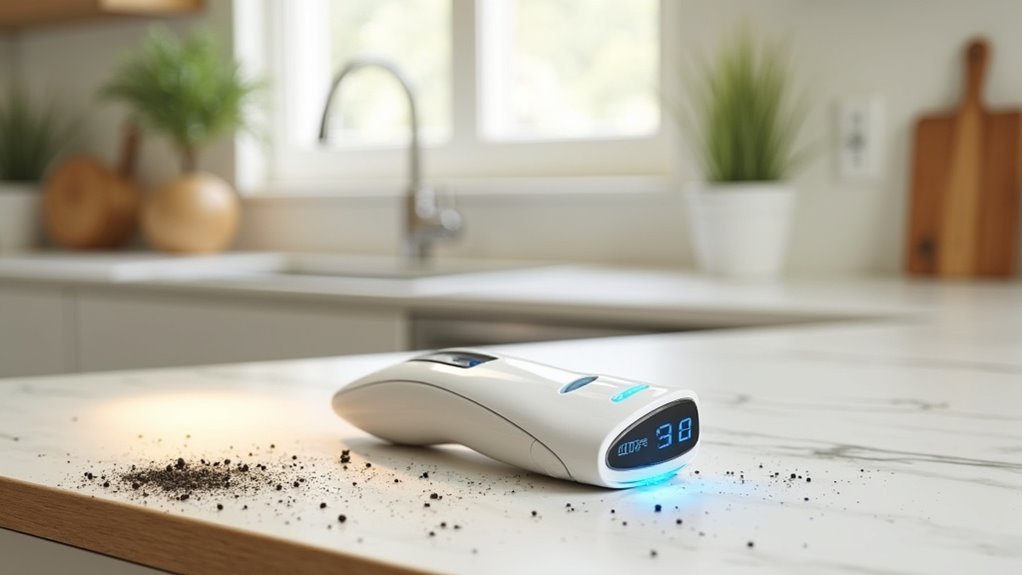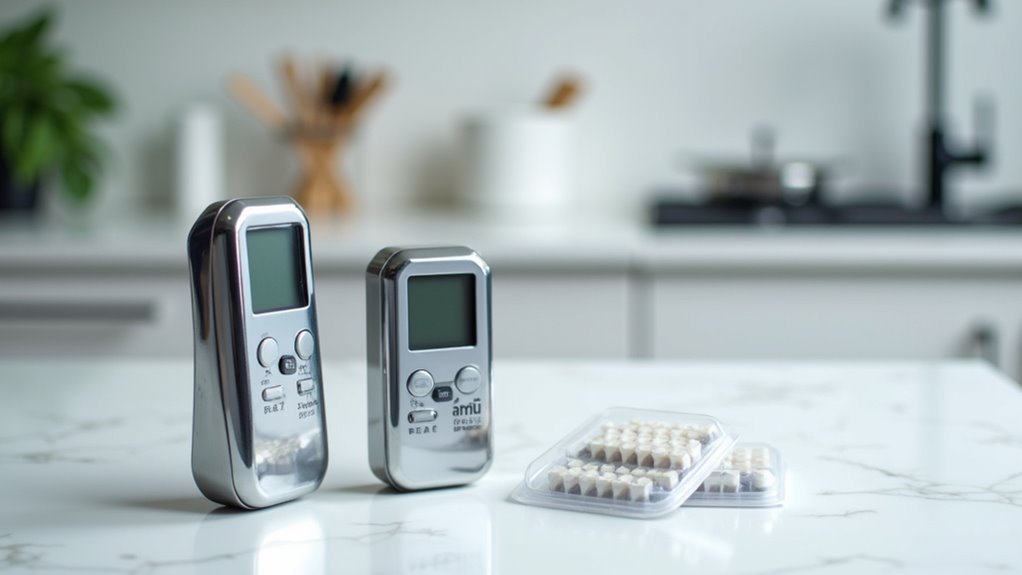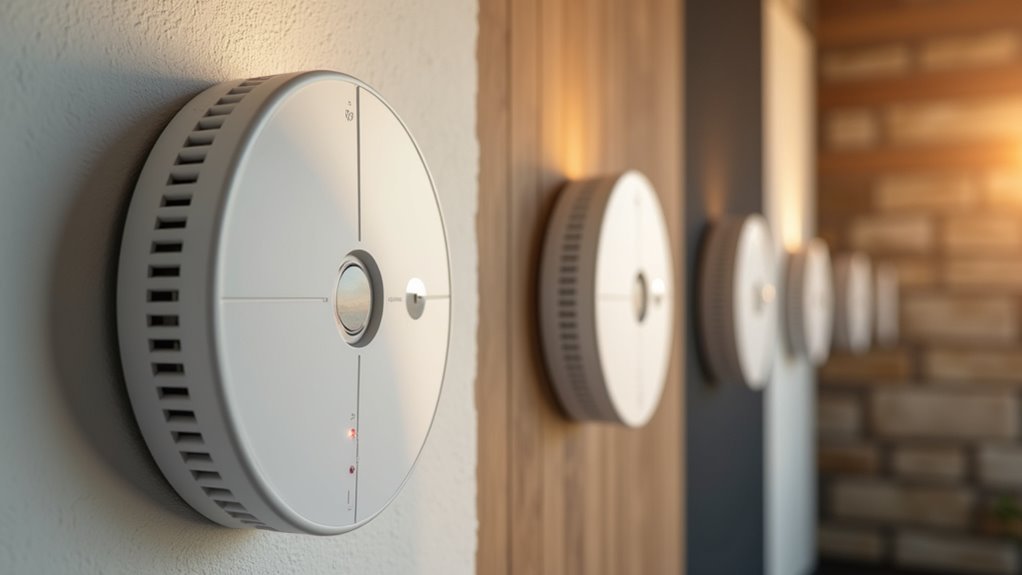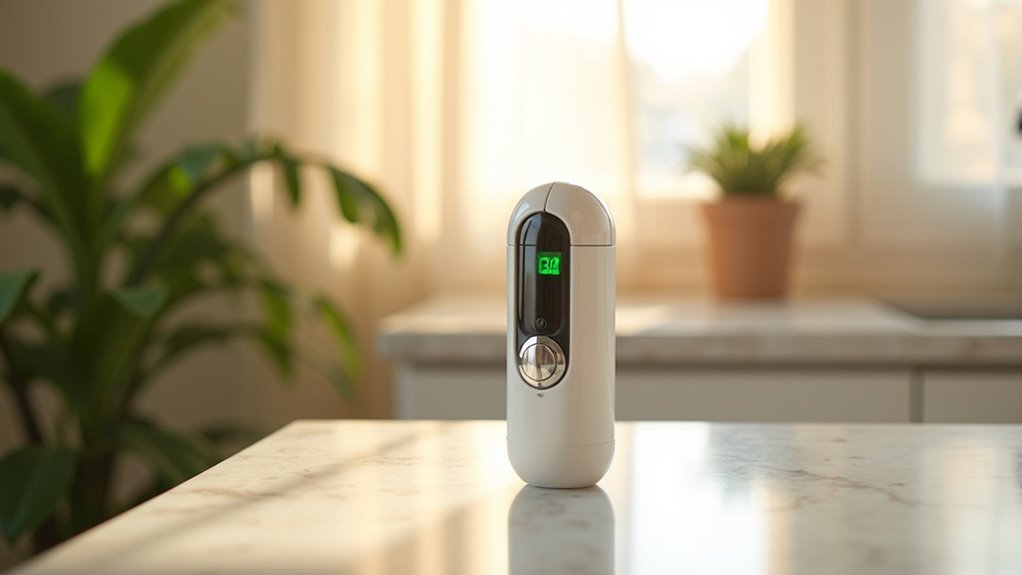You’ve probably walked into a room and noticed that musty smell, wondering if there’s something lurking behind your walls or under your floors. Your instincts aren’t wrong – mold can establish colonies in your home long before you see visible signs, quietly compromising your indoor air quality and potentially affecting your family’s health. While professional mold testing delivers thorough results, it’s not always practical for routine monitoring.
Understanding the Importance of Early Mold Detection

When you’re dealing with potential mold issues in your home, early detection can make the difference between a minor cleanup and a major health crisis.
Mold spores don’t wait—they’ll start multiplying within 24 to 48 hours in damp conditions, creating serious health hazards for you and your family, especially if someone has allergies or respiratory conditions.
The early detection of mold protects your indoor air quality before problems escalate. You can’t always see mold growth with your naked eye, which is why mold testing kits become essential tools.
Invisible mold threats lurk beyond what your eyes can detect, making professional testing kits your first line of defense.
These affordable detectors help you identify various mold species within 48 hours, giving you the information you need to take action. By catching mold early, you’ll make informed decisions about remediation and maintain a healthier living environment.
Types of Affordable Mold Testing Solutions Available
Since mold detection doesn’t require breaking the bank, you’ll find several affordable testing solutions that deliver reliable results for your home. DIY mold test options range from simple surface testing to thorough air quality monitoring systems.
| Test Kit | Price Range | Testing Time |
|---|---|---|
| HAATEST Mold Test Kit | Budget-friendly | 48 hours |
| Mold Armor DIY Kit | $9.98 + $40 lab fee | Varies |
| Healthful Home 5-Minute Test | Low cost + lab fees | 5 minutes |
These mold test kits offer different approaches to detection. Surface testing kits like HAATEST provide sterile swabs and test plates for immediate assessment. For ongoing monitoring, the Airthings 4200 House Kit ($279.99) delivers real-time air quality data and mold growth alerts. Most affordable mold testing solutions require additional lab analysis fees for detailed mold identification.
Best Surface Testing Kits for Visible Mold Investigation

Surface testing kits excel at identifying mold contamination on specific areas where you’ve spotted suspicious growth or discoloration. These kits help you collect samples from walls, furniture, and HVAC systems for thorough lab analysis.
Here are the top surface testing kit options:
- HAATEST Mold Test Kit – Includes 12 test plates and 20 sterile swabs for multiple testing locations throughout your home.
- My Mold Detective – Offers versatile testing with indoor/outdoor air tests plus tape strips for surface sampling.
- Mold Armor DIY Mold Test Kit – Budget-friendly at $9.98 for indoor and outdoor environment testing (additional lab fees apply).
Each mold testing kit requires sending samples to laboratories for professional analysis.
Most providers offer quick turnaround times, enabling you to make informed decisions about remediation needs while maintaining affordability for effective surface testing.
Top Air Quality Monitoring Devices for Preventive Care
You’ll find that professional-grade detection technology in modern air quality monitors offers laboratory-level accuracy at consumer-friendly prices.
These devices provide real-time monitoring of humidity, temperature, and airborne particles that signal potential mold development before visible growth occurs.
Cost-effective prevention solutions like the Airthings 4200 House Kit let you track multiple rooms simultaneously, giving you actionable data to maintain ideal conditions and avoid expensive remediation costs.
Professional Grade Detection Technology
While basic mold detectors serve their purpose, professional-grade air quality monitoring devices offer extensive environmental insights that transform how you approach mold prevention.
Advanced systems like the Airthings 4200 House Kit deliver thorough insights into temperature, humidity, and radon levels—all critical factors in mold development.
These sophisticated monitors provide:
- Real-time monitoring capabilities with smartphone app integration for instant alerts
- Continuous assessment that eliminates frequent lab testing requirements
- Subtle change detection enabling preventative action before visible mold appears
You’ll receive immediate notifications when conditions become conducive to mold growth, allowing proactive intervention.
This technology enhances your indoor air quality while minimizing health risks for allergy-sensitive family members, making professional-grade air quality monitoring an invaluable investment in your home’s environmental health.
Real-Time Air Monitoring
These advanced monitors connect to smartphone apps, delivering instant notifications when indoor air quality deteriorates. You’ll receive historical data showing humidity fluctuations that could indicate potential mold risks in basements, bathrooms, and other vulnerable areas.
| Device Feature | Benefit |
|---|---|
| Continuous monitoring | Early mold detection |
| App connectivity | Instant alerts |
| Multi-parameter tracking | Extensive air analysis |
| Historical data | Pattern recognition |
Devices like My Mold Detective Mold Test Kit enable air sampling for both indoor and outdoor environments, helping you maintain ideal air quality year-round.
Cost-Effective Prevention Solutions
Investing in preventive air quality monitoring can save you hundreds of dollars compared to professional mold remediation costs.
Cost-effective prevention solutions help you catch mold presence before it becomes a serious health hazard or expensive problem.
Smart monitoring devices like the Airthings 4200 House Kit track humidity, temperature, and radon levels for $279.99, alerting you to conditions that promote mold growth.
When you need immediate results, mold testing kits offer affordable alternatives:
- Healthful Home Store 5-Minute Test – Quick results in five minutes for $37.47
- Mold Armor DIY Kit – Three testing methods for indoor/outdoor use at $9.98
- ImmunoLytics DIY Kit – Multi-room testing with free consultation
These tools maintain healthy indoor air quality while preventing costly remediation down the road.
Quick Result Test Kits for Immediate Assessment
When you need immediate answers about potential mold problems in your home, quick result test kits offer the fastest path to assessment.
The Healthful Home Store 5-Minute Mold Test delivers feedback within minutes of sample collection, letting you quickly evaluate your air quality.
For more thorough analysis, the GOT MOLD? kit provides professional-grade testing with a detailed report ready in under a week, making results easy to understand.
My Mold Detective simplifies the process into three straightforward steps, including both indoor and outdoor testing.
The budget-friendly Mold Armor kit costs just $9.98 upfront, though lab analysis adds $40 for identification.
These quick result test kits are easy to use, featuring user-friendly instructions that help beginners confidently test for mold throughout their homes.
Multi-Room Testing Solutions for Comprehensive Coverage

While single-room testing provides valuable insights, thorough mold assessment requires evaluating multiple areas throughout your home.
Multi-room testing solutions offer extensive assessments that identify potential problems across various living spaces, ensuring nothing gets overlooked.
These affordable mold detectors provide several testing options:
- ImmunoLytics DIY Mold Test Kit – Purchase multiple kits for flexible testing across different rooms and areas.
- GOT MOLD? Test Kit – Choose from 1-room, 2-room, or 3-room options with professional-quality analysis included.
- My Mold Detective Kit – Test both indoor and outdoor air for complete environmental evaluation.
For larger homes, you’ll need additional air sampling cassettes since one typically covers a normal-sized room.
These extensive air quality evaluations boost your confidence by enabling repeated assessments, helping you identify and address mold issues throughout your entire home.
Laboratory-Grade Home Testing Options
For homeowners seeking the most accurate mold detection results, laboratory-grade home testing options deliver professional-level analysis without the expense of hiring specialists.
The HAATEST Mold Test Kit exemplifies laboratory-grade testing by detecting various mold species within 48 hours, providing reliable indoor air quality assessment. You’ll receive 12 test plates and 20 sterile swabs for thorough testing throughout your home.
Laboratory-grade mold detection in 48 hours with 12 test plates and 20 sterile swabs for comprehensive home assessment.
GOT MOLD? Test Kit offers professional-quality mold testing with detailed lab reports featuring color-coded interpretations, delivering results in under a week.
My Mold Detective simplifies the process with a three-step air testing system that includes both indoor and outdoor analysis.
These affordable mold detectors bridge the gap between basic home tests and expensive professional services, giving you laboratory accuracy at a fraction of the cost.
Essential Features to Consider When Choosing Test Kits
Since selecting the right mold test kit directly impacts the accuracy of your results, you’ll want to prioritize laboratory-grade testing capabilities that guarantee sterile production and reliable detection. The HAATEST Mold Test Kit exemplifies this standard, delivering results within 48 hours.
When evaluating options, focus on these critical features:
- Comprehensive supplies – Look for kits offering multiple test plates (like HAATEST’s 12 plates) and sterile swabs (20 included) for thorough home testing.
- Clear guidance – Choose kits where instructions are easy to follow, especially if you’re new to mold detection.
- Educational resources – Prioritize kits including a mold identification guide to understand species types and health implications.
Additionally, verify the kit provides after-sales support for product exchanges and detection advice, ensuring you’re covered throughout the testing process.
Step-by-Step Guide to Using At-Home Mold Detectors
After purchasing your mold test kit, you’ll want to start by carefully unpacking all components and verifying you have everything needed for extensive testing.
Read the provided instructions carefully before beginning your mold inspection. Use sterile swabs or tape for collecting samples from suspected areas like bathrooms, basements, or anywhere you’ve noticed musty odors or visible growth.
Place samples onto test plates as directed, then allow them to incubate for the recommended 48-hour period.
Once incubation’s complete, examine growth patterns using the identification guide to interpret your DIY test results.
If you discover serious contamination, don’t rely solely on at-home testing—contact professionals for thorough assessment and remediation planning to guarantee your family’s safety.
Interpreting Your Test Results Accurately
Once you’ve completed your at-home mold test, you’ll need to interpret the results correctly to determine if there’s a genuine health concern in your home.
Understanding lab report data becomes essential since DIY kits can produce misleading results that differ considerably from professional assessments.
Knowing when the situation requires expert intervention will help you make informed decisions about your family’s safety and potential remediation needs.
Understanding Lab Report Data
When you receive your mold test results, you’ll encounter a detailed lab report that breaks down the specific mold species found in your home, their concentration levels, and potential health implications.
This thorough testing document provides essential data about mold spores detected through your air test, helping you understand your indoor air quality.
Understanding your lab report involves recognizing these key elements:
- Color-coded severity indicators – Visual markers showing concentration levels from safe to concerning
- Indoor vs. outdoor comparisons – Data comparing your home’s mold levels to external environmental conditions
- Species identification – Specific types of mold detected and their associated health risks
Remember that sample collection conditions, airflow patterns, and environmental factors can affect accuracy.
Always review any disclaimers included, as these explain potential limitations and recommend professional consultation for serious concerns.
Professional Vs DIY Results
Now that you can interpret the data in your lab reports, you need to understand the significant differences between professional and DIY test results. Professional Mold assessments deliver thorough inspections with detailed lab testing, while DIY kits offer cost-effective but potentially incomplete findings due to user error.
| Aspect | Professional Testing | DIY Kits |
|---|---|---|
| Detection Scope | Hidden and surface mold | Surface mold only |
| Accuracy | Expert interpretation | Basic results, potential false positives |
| Analysis Quality | Identifies types and concentrations | Limited context provided |
| Reliability | Thorough assessment | May miss mold in your home |
DIY kits can’t detect hidden mold behind walls, making them unreliable for complete evaluations. You’ll need expert consultation to confirm DIY findings and develop effective remediation plans.
When to Seek Help
While DIY mold test results can give you a starting point, knowing when to seek professional help is critical for your health and safety.
At-home testing has limitations that can lead to misinterpretation of results and missed hidden mold sources.
You should contact a professional mold inspector if:
- Your DIY test shows elevated mold levels – Lab results indicating high concentrations require expert interpretation and thorough remediation planning.
- You suspect hidden mold growth – Professional testing utilizes advanced tools to detect mold in areas your at-home kit can’t reach.
- Health symptoms persist despite negative results – Environmental variables and user error can affect DIY accuracy, making professional assessment necessary.
Don’t rely solely on preliminary insights from affordable detectors when your family’s health is at stake.
When to Upgrade From DIY Testing to Professional Assessment
How do you know if your DIY mold testing has reached its limits? When visible mold appears, the EPA recommends skipping further testing and moving straight to removal.
When visible mold appears, the EPA recommends skipping further testing and moving straight to removal.
You’ll need professional assessment when your home tests show high spore levels or potential health risks, as mold inspectors can accurately interpret results and develop effective remediation strategies.
If you have respiratory issues or allergies, don’t hesitate to call experts once you’ve confirmed mold presence through DIY testing. They’ll provide tailored solutions for your health concerns.
Additionally, inconsistent results or confusion about mold types signal it’s time for professional evaluation. Experts guarantee thorough inspection and address all hidden mold sources your DIY methods might’ve missed.
Cost Comparison Between Home Testing and Professional Services
When you’re deciding between DIY mold testing and professional services, you’ll find home kits cost $10-$50 while professional inspections range from $300-$1,000 depending on your property’s size and complexity.
Professional services typically run around $500 on average, but they’ll provide thorough air quality measurements, laboratory analysis, and expert remediation recommendations that home kits can’t match.
You’ll need to weigh the immediate savings of DIY testing against the long-term value of professional expertise, especially since significant mold findings often require follow-up professional assessment anyway.
Professional Inspection Pricing
Before deciding between DIY and professional mold testing, you’ll need to understand the significant price differences between these options.
Professional inspection pricing typically ranges from $300 to $800, depending on your property’s size and testing requirements. Meanwhile, at-home testing kits cost only $10 to $50 upfront.
However, you should consider these key factors:
- Accuracy of results – Professional assessments provide extensive visual inspections, moisture measurements, and air quality testing that DIY kits can’t match.
- Hidden costs – Mold removal and remediation services can add $500 to $6,000 to your total expenses.
- Expertise value – Certified inspectors offer thoroughness and knowledge that home kits simply can’t replicate.
While DIY options provide cost-effective initial screening, they’re not substitutes for professional expertise.
Home Kit Costs
Home testing kits offer substantial savings compared to professional inspections, with most options priced between $10 and $40. You’ll find kits like HAATEST provide 12 test plates and materials for thorough home assessment without recurring fees.
Professional inspections cost $300 to $1,000 depending on your property’s size and complexity.
When you test your air with affordable home kits, lab analysis fees are typically included in the initial purchase price. Professionals often charge additional fees for laboratory testing and detailed reporting.
You can use home kits as preliminary assessments to identify potential mold issues at a fraction of professional costs.
If results indicate problems requiring removal and remediation, you can then invest in professional follow-up services for accuracy confirmation and treatment planning.
Long-term Value Analysis
Value emerges differently when you compare the cumulative costs of home testing kits versus professional services over time.
While affordable mold detectors initially cost $10-50 compared to professional mold inspection fees of $300-1,000, you’ll likely need multiple home tests for ongoing monitoring. This repeated testing can quickly match professional assessment costs.
Consider these long-term value factors:
- Comprehensive Coverage – Professionals identify moisture sources and air quality issues that home kits miss.
- Prevention Benefits – Early detection of hidden problems prevents expensive remediation later.
- Cost Accumulation – Multiple home testing sessions over time often equal one thorough professional evaluation.
For effective long-term mold management, you’re investing in expertise that addresses root causes rather than just surface symptoms, potentially saving thousands in future remediation costs.
Maintaining Your Testing Equipment for Reliable Results
While affordable mold detectors can provide accurate results, they’ll only perform effectively if you maintain them properly. Your air sampling pump and other reusable equipment require consistent care to guarantee reliable sample collection.
Always refrigerate unused test kits once opened to prevent degradation of testing materials. Check that your kit includes all necessary components and verify expiration dates regularly, as expired materials yield unreliable results.
Clean and maintain reusable devices like the BioVac™ Air Sampler thoroughly between uses, since contamination affects accuracy.
Store all equipment in cool, dry locations away from direct sunlight to preserve material integrity. Follow manufacturer instructions precisely when refilling or reusing components like air sampling cassettes.
Proper maintaining practices extend equipment lifespan while guaranteeing consistently accurate mold detection results for your home’s air quality monitoring.
Creating an Ongoing Mold Prevention Strategy
Since effective mold detection is only one piece of the puzzle, you’ll need a detailed prevention strategy to keep your home mold-free long-term.
Preventing the conditions that encourage mold growing requires consistent monitoring and proactive maintenance throughout your living spaces.
Your extensive prevention approach should include:
- Monitor humidity levels regularly, keeping them below 50% using dehumidifiers in basements and bathrooms to eliminate excess moisture.
- Conduct routine inspections around plumbing fixtures, roofs, and windows to catch water leaks before mold develops.
- Implement regular testing with a reliable mold test kit like HAATEST to assess air quality and detect early mold presence.
Additionally, maintain proper ventilation using exhaust fans and choose mold-resistant materials during renovations to create lasting protection against future infestations.
Frequently Asked Questions
Is There a Device That Detects Mold in the Air?
You can’t directly detect mold in air with consumer devices. Air quality monitors track humidity and temperature that promote mold growth, but you’ll need professional air sampling or lab-tested home kits for actual detection.
What Is the Best Air Quality Sensor for Mold?
You can’t directly detect mold with air quality sensors, but the Airthings 4200 House Kit’s your best option for monitoring conditions like humidity and temperature that promote mold growth and alert you to risks.
Is There a Way to Test Air Quality for Mold?
You can test air quality for mold using at-home test kits like HAATEST, which provide results within 48 hours, or hire professionals with specialized equipment for thorough assessments and hidden mold detection.
Do Mold Detectors Really Work?
Mold detectors do work for basic detection, but you’ll get mixed results. They can’t find hidden mold behind walls and may give false readings, so you shouldn’t rely on them for thorough assessments.





Leave a Reply